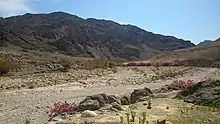Wadi Feynan
Wadi Feynan or Wadi Faynan (Arabic: وادي فينان) is a major wadi (seasonal river valley) and region in southern Jordan, on the border between Tafilah Governorate and Aqaba and Ma'an Governorates. It originates in the southern Jordanian Highlands with the confluence of Wadi Dana and Wadi Ghuweyr, and drains into the Dead Sea via Wadi Araba.

Historically, the area had the largest copper deposits in the Southern Levant, which were intensively exploited from the Chalcolithic (4500–3100 BCE) through to the Mamluk period (1250–1516 CE).[1][2] It also has a number of significant early prehistoric sites.[3][4][5]
Part of the wadi is included in the Dana Biosphere Reserve. The Royal Society for the Conservation of Nature (RSCN) opened the first of its eco hotels, the Feynan Ecolodge, there in 2005.[6][7]
Archaeological sites
- Barqa al-Hetiye
- Khirbat Faynan
- Khirbat en-Nahas
- Wadi Faynan 16
Excavations
Archaeological sites in Faynan have been extensively excavated by the Edom Lowlands Regional Archaeology Project, led by Thomas E. Levy and Mohammad Najjar. Levy and Najjar have argued that Iron Age sites in the region relate to the earliest phases of the Biblical kingdom of Edom. These scholars, along with Erez Ben-Yosef, also argue that Pharaoh Shoshenk I of Egypt (the Biblical "Shishak"), who attacked Jerusalem in the 10th century BC, encouraged the trade and production of copper instead of destroying the region.[8][9][10]
See also
References
- "Wadi Faynan, Copper Mine". World Archaeology. No. 13. 2005-09-07. Archived from the original on 2017-01-10. Retrieved 2017-01-09.
- Novo, Alexandre; Vincent, Matthew L.; Levy, Thomas E. (2012-08-29). "Geophysical Surveys at Khirbat Faynan, an Ancient Mound Site in Southern Jordan". International Journal of Geophysics. 2012: 1–8. doi:10.1155/2012/432823. ISSN 1687-885X.
- Finlayson, Bill; Mithen, Steven; Carruthers, Denise; Kennedy, Amanda; Pirie, Anne; Tipping, Richard (2000-01-01). "The Dana-Faynan-Ghuwayr Early Prehistory Project". Levant. 32 (1): 1–26. doi:10.1179/lev.2000.32.1.1. ISSN 0075-8914. S2CID 140169403.
- Finlayson, Bill; Mithen, Steven, eds. (2007-01-01). "Archaeological Survey of Wadis Faynan, Ghuwayr and al Bustan and Evaluation of the Pre-Pottery Neolithic a Site of WF16". The Early Prehistory of Wadi Faynan, Southern Jordan: Archaeological Survey of Wadis Faynan, Ghuwayr and Al Bustan and Evaluation of the Pre-Pottery Neolithic A Site of WF16. Vol. 4. Oxbow Books. ISBN 9781842172124. JSTOR j.ctt1cd0nbr.
- "New excavations at WF16, a Pre-Pottery Neolithic A site in southern Jordan". Antiquity. Archived from the original on 2017-01-10. Retrieved 2017-01-09.
- "Feynan Ecolodge". EcoHotels. 2013-05-11. Archived from the original on 2017-01-10. Retrieved 2017-01-09.
- Costas, Chris; Siber, Kate (November 2008). "Top Ecolodges: Desert". National Geographic Adventure. National Geographic Society. Archived from the original on 2017-01-20. Retrieved 2017-01-09.
- "Israeli researchers identify biblical kingdom of Edom - Israel News - Jerusalem Post". www.jpost.com. Archived from the original on 2019-09-27. Retrieved 2019-09-28.
- Amanda Borschel-Dan. "Bible-era nomadic Edomite tribesmen were actually hi-tech copper mavens". www.timesofisrael.com. Archived from the original on 2019-09-27. Retrieved 2019-09-28.
- Ben-Yosef, Erez; Liss, Brady; Yagel, Omri A.; Tirosh, Ofir; Najjar, Mohammad; Levy, Thomas E. (2019-09-18). "Ancient technology and punctuated change: Detecting the emergence of the Edomite Kingdom in the Southern Levant". PLOS ONE. 14 (9): e0221967. Bibcode:2019PLoSO..1421967B. doi:10.1371/journal.pone.0221967. ISSN 1932-6203. PMC 6750566. PMID 31532811.